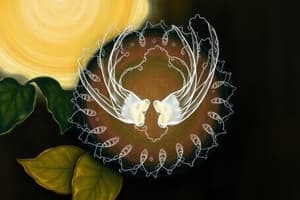Podcast
Questions and Answers
Meiosis I produces _____ cells, each of which is _____.
Meiosis I produces _____ cells, each of which is _____.
Two...Haploid
Meiosis II typically produces _____ cells, each of which is _____.
Meiosis II typically produces _____ cells, each of which is _____.
Four...Haploid
During _____ sister chromatids separate.
During _____ sister chromatids separate.
anaphase II
At the end of _____ and cytokinesis, haploid cells contain chromosomes that each consist of two sister chromatids.
At the end of _____ and cytokinesis, haploid cells contain chromosomes that each consist of two sister chromatids.
Synapsis occurs during _____.
Synapsis occurs during _____.
Homologous chromosomes migrate to opposite poles during _____.
Homologous chromosomes migrate to opposite poles during _____.
During _____ chromosomes align single file along the equator of a haploid cell.
During _____ chromosomes align single file along the equator of a haploid cell.
At the end of _____ and cytokinesis there are four haploid cells.
At the end of _____ and cytokinesis there are four haploid cells.
During _____ a spindle forms in a haploid cell.
During _____ a spindle forms in a haploid cell.
What happens to DNA content and ploidy levels during meiosis I and meiosis II?
What happens to DNA content and ploidy levels during meiosis I and meiosis II?
What processes lead to most genetic variation in sexually reproducing organisms?
What processes lead to most genetic variation in sexually reproducing organisms?
Study Notes
Meiosis Overview
- Meiosis consists of two main stages: Meiosis I and Meiosis II, resulting in halved chromosome numbers.
Meiosis I
- Meiosis I produces two haploid cells, each containing chromosomes made up of two sister chromatids.
- Synapsis occurs during prophase I, where homologous chromosomes pair up.
- Homologous chromosomes move to opposite poles during anaphase I.
- At the end of telophase I and cytokinesis, there are two haploid cells, each still having sister chromatids.
Meiosis II
- Meiosis II typically produces four haploid cells with chromosomes, each made up of sister chromatids.
- A spindle apparatus forms during prophase II in each haploid cell.
- Chromosomes align single file along the equator during metaphase II, similar to mitotic metaphase but in haploid cells.
- Sister chromatids separate during anaphase II.
- Telophase II and cytokinesis result in four haploid cells with individual chromosomes.
DNA Content and Ploidy
- DNA content is halved during both Meiosis I and Meiosis II.
- Ploidy changes from diploid to haploid in Meiosis I, maintaining a haploid state in Meiosis II.
Genetic Variation
- Key processes that contribute to genetic variation in sexually reproducing organisms include:
- Crossing over during prophase I.
- Independent assortment of chromosomes during Meiosis I.
- Random fertilization of gametes.
Studying That Suits You
Use AI to generate personalized quizzes and flashcards to suit your learning preferences.
Description
Test your knowledge on meiosis with these flashcards from Chapter 10. Learn about the processes of Meiosis I and II, the number of cells produced, and key phases such as anaphase II. Perfect for studying and reinforcing key concepts related to cell division.




